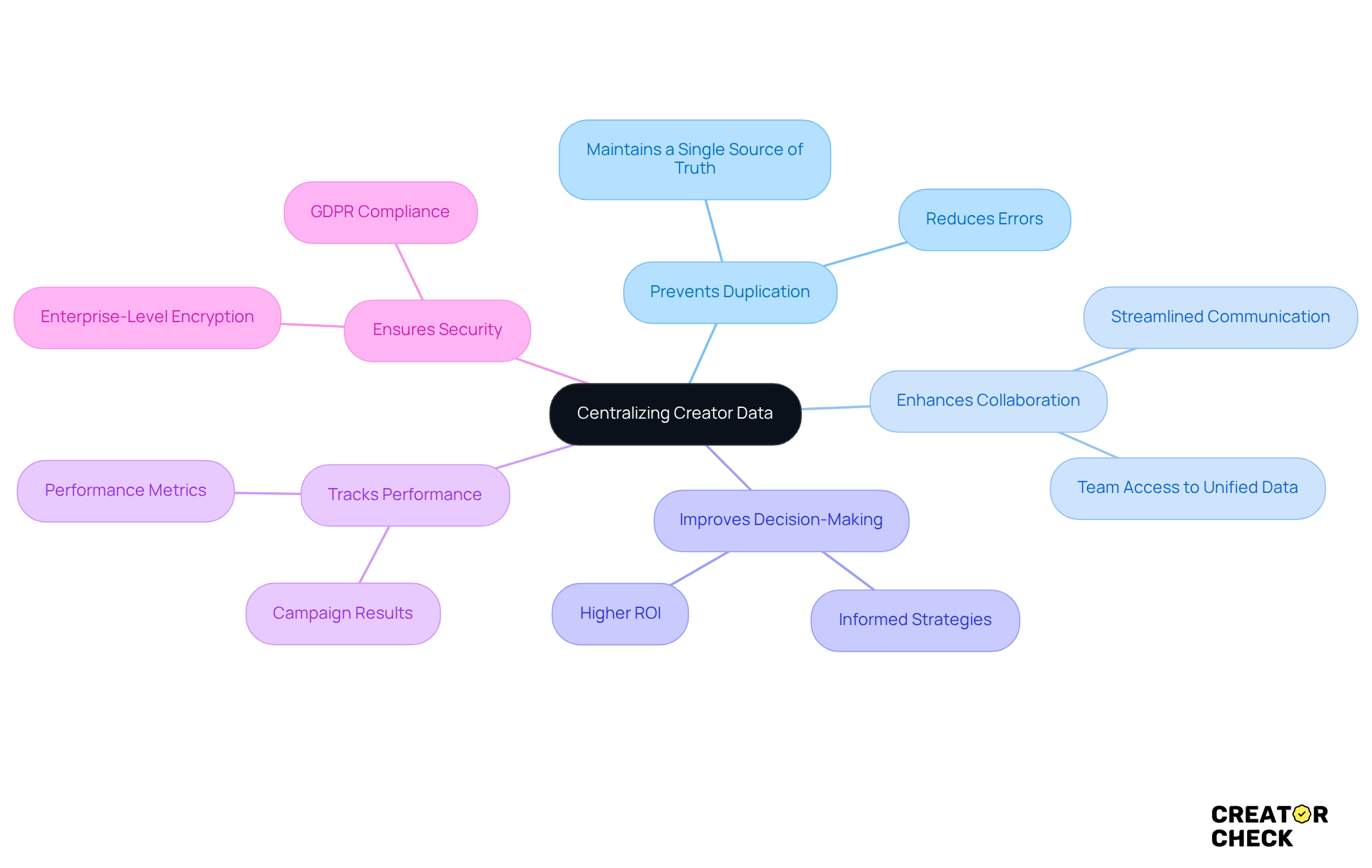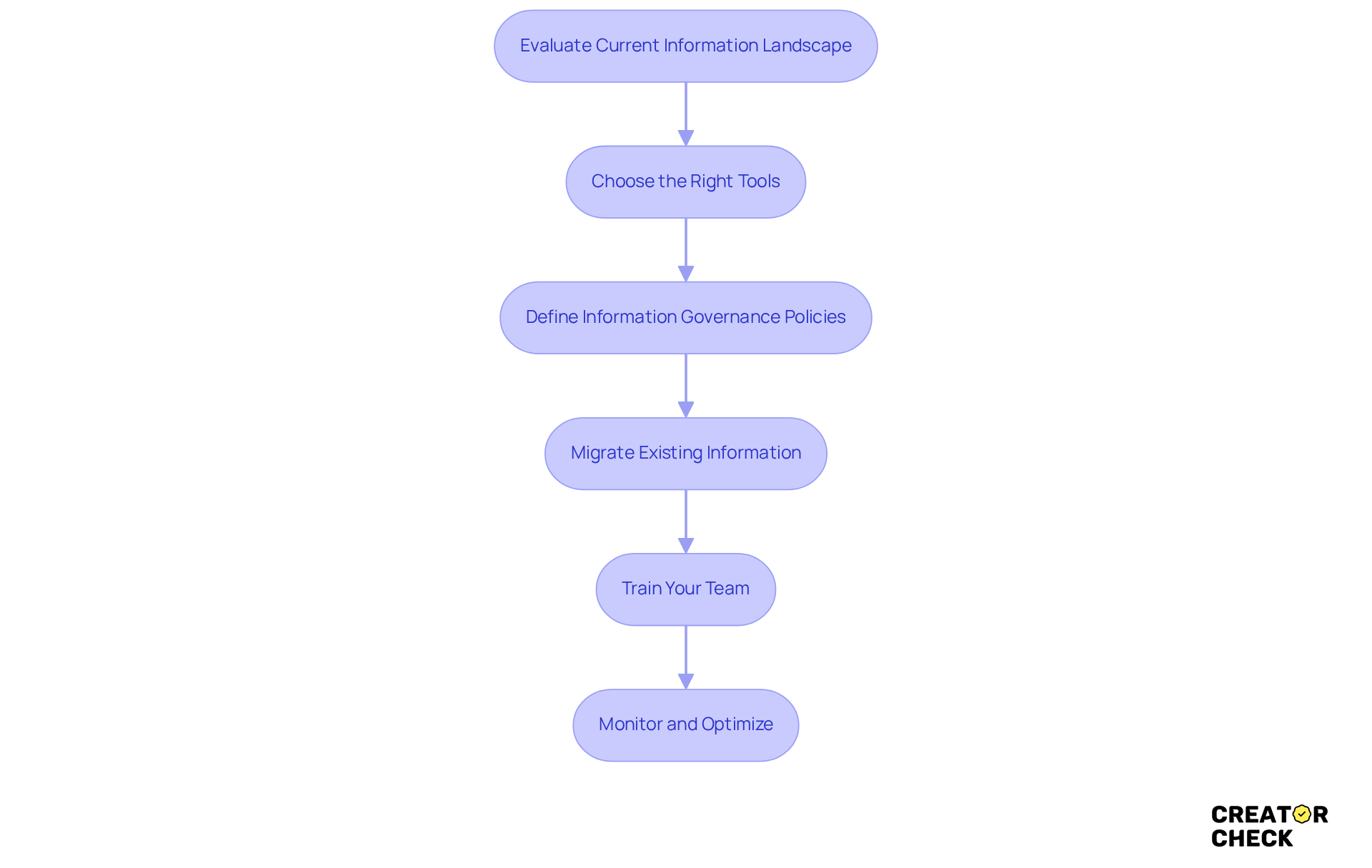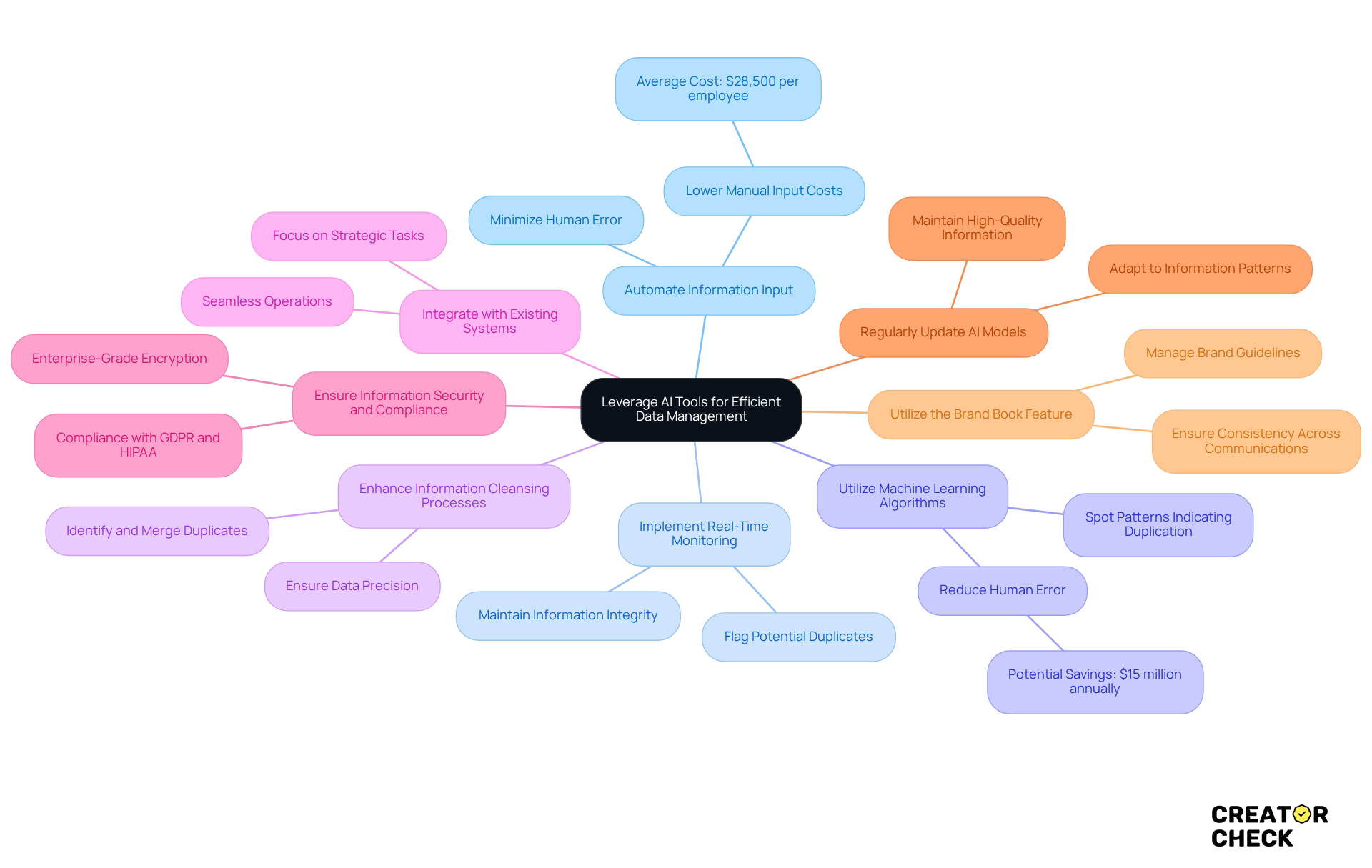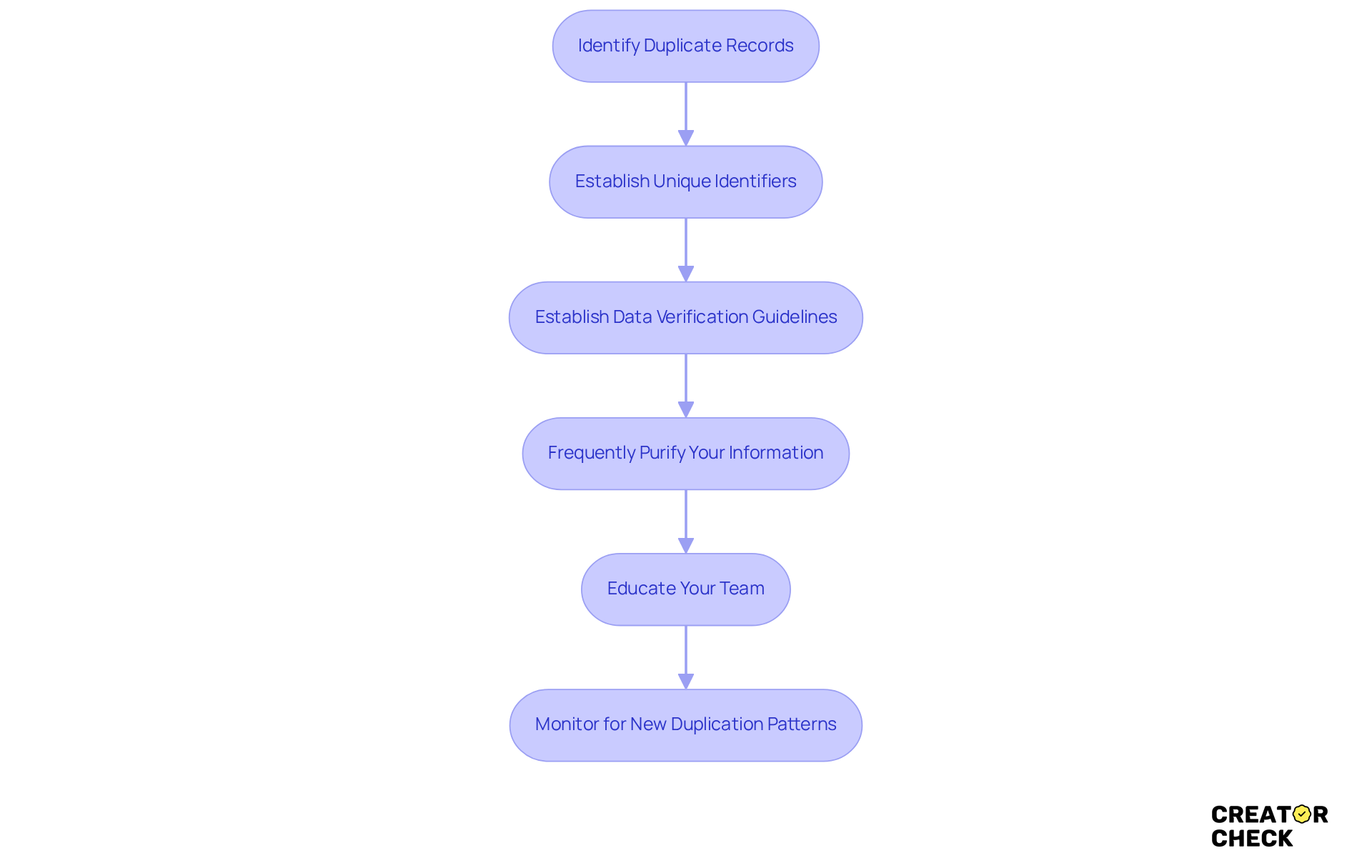Overview
This article highlights why centralizing creator data is so important—it helps prevent duplication, which is key to boosting operational efficiency and accuracy in influencer organizations. But how do we make this happen? Well, it lays out some essential steps for implementation.
- Evaluate your existing data sources.
- Choose the right tools for the job.
- Leverage AI for real-time monitoring and data cleansing.
All these actions contribute to creating a single source of truth that not only minimizes errors but also enhances decision-making. So, what does this mean for you? By centralizing your data, you’re setting yourself up for success in a big way!
Introduction
Centralizing creator data isn’t just a passing trend; it’s a vital strategy for influencer agencies that want to boost their efficiency and accuracy. By bringing all that information into one spot, organizations can cut down on the risks tied to data duplication, which often leads to those annoying operational inconsistencies and costly mistakes.
But here’s the real question: how can agencies put in place a centralized data management system that not only smooths out workflows but also keeps sensitive information safe?
Let’s dive into the key steps and best practices for agencies eager to centralize their creator data, paving the way for smoother operations and better decision-making.
Understand the Importance of Centralizing Creator Data
For influencer organizations, centralizing creator data to prevent duplication is super important. Why? Because centralizing creator data to prevent duplication helps to cut down on the risks tied to information duplication, which can lead to inconsistencies and operational hiccups. When you bring all that info into one place, everyone on the team can access the same data. This significantly lowers the chances of errors popping up from multiple sources. Plus, it makes decision-making smoother and boosts collaboration among team members. After all, when everyone is on the same page about creator details, campaign statuses, and financial transactions, things just flow better.
And there’s more! A centralized approach also makes it easier to track creator performance and campaign results. This means you can craft more informed strategies, ultimately leading to a higher ROI. Imagine an organization juggling multiple creators; it’s not uncommon for different team members to accidentally enter the same creator's info into various systems. This can create discrepancies in reporting and analysis. By centralizing creator data to prevent duplication, the organization can consolidate that information and maintain a single source of truth, ensuring accuracy and reliability in their operations. It streamlines workflows and empowers organizations to make data-driven decisions that enhance overall performance.
Oh, and let’s not forget about security! Creator Check's enterprise-level encryption and adherence to GDPR standards ensure that sensitive information is well protected. This allows agencies to handle creator information with confidence while focusing on revenue growth and operational efficiency. So, what does this mean for you? It’s all about working smarter, not harder!

Implement a Centralized Data Management System
To effectively implement a centralized data management system, let’s walk through some key steps together:
-
Evaluate Your Current Information Landscape: Start by taking a good look at your existing information sources to spot areas of duplication. This evaluation will help clarify the extent of the issue and highlight the necessity of centralizing creator data to prevent duplication.
-
Choose the Right Tools: It’s important to pick an information management platform that fits your organization’s specific needs. Look for features like automated information input, real-time updates, and seamless integration with your current tools. For instance, platforms like Creator Check offer an all-in-one solution tailored for influencer agencies, making the management process a breeze.
-
Define Information Governance Policies: Next up, establish clear guidelines for entry, maintenance, and access. This means setting permissions for team members and outlining protocols for updates to prevent unauthorized changes, ensuring that your information stays intact across the board.
-
Migrate Existing Information: Now, it’s time to carefully transfer your existing information into the new centralized system. During this migration, don’t forget to cleanse the data by centralizing creator data to prevent duplication and ensure accuracy. Using information cleansing tools can really help out during this process.
-
Train Your Team: Make sure to provide thorough training for your team on how to effectively use the new framework. Emphasize the importance of preserving information integrity and following the governance policies to foster a culture of accountability.
-
Monitor and Optimize: After you’ve implemented the system, keep an eye on it to catch any issues or areas that need improvement. Regularly check entries to ensure everyone is sticking to the governance policies and make necessary tweaks to boost efficiency.
So, what does this mean for you? By following these steps, you’ll not only streamline your data management but also create a more efficient and accountable environment for your agency.

Leverage AI Tools for Efficient Data Management
Incorporating AI tools into your information management strategy can really amp up your efficiency and precision while keeping your information safe. So, how can you leverage AI for effective data management? Let’s break it down:
-
Automate Information Input: Think about using AI-powered tools to streamline how you input information. This can help minimize human error and ensure that information submission is consistent across all platforms. Plus, automating this process can lower the typical expense of manual input, which is around $28,500 per employee each year.
-
Implement Real-Time Monitoring: You can utilize AI tools that keep an eye on entries in real-time, flagging potential duplicates as they pop up. This proactive approach helps maintain information integrity right from the start by centralizing creator data to prevent duplication, effectively tackling that pesky problem that can lead to costly mistakes.
-
Utilize Machine Learning Algorithms: Consider employing machine learning algorithms to sift through your existing information and spot patterns that might indicate duplication. These algorithms can learn from past entries, improving over time and reducing the risk of human error, which can be addressed by centralizing creator data to prevent duplication, potentially saving companies an average of $15 million annually due to inaccuracies.
-
Enhance Information Cleansing Processes: AI can be a real game-changer when it comes to cleansing your data. By centralizing creator data to prevent duplication, it can automatically identify and merge duplicate records, saving you time and ensuring your information stays precise and current—essential for making informed business decisions.
-
Integrate with Existing Systems: Look for AI tools that fit seamlessly with your current information management systems. This kind of integration can lead to smoother operations and improved efficiency, allowing your top employees to focus on strategic tasks instead of repetitive input.
-
Ensure Information Security and Compliance: Don’t forget about security! Using enterprise-grade encryption can protect your information, and sticking to GDPR and other protection standards helps safeguard sensitive material. Plus, limiting access to sensitive information within your agency boosts trust and reliability in your information management processes.
-
Regularly Update AI Models: Keep your AI models fresh with new information and insights to ensure they perform at their best. Regular updates help the system adapt to changes in information patterns, which is essential for centralizing creator data to prevent duplication and maintaining high-quality information.
-
Utilize the Brand Book Feature: Make the most of the Brand Book feature to keep consistency across your creator roster. This tool helps manage brand guidelines and ensures that all communications align with your organization’s standards.
By embracing these strategies, influencer agencies can tap into the power of AI to optimize their information management processes, ultimately boosting operational efficiency and driving revenue growth. So, what are you waiting for? Let’s get started!

Troubleshoot Common Data Duplication Issues
Even with a centralized information management system, centralizing creator data to prevent duplication can still face issues. Let’s explore some common problems and how to troubleshoot them:
-
Identify Duplicate Records: Regular audits are key! Check your information regularly to spot those pesky duplicate records. Profiling tools can help you sift through your datasets and flag duplicates.
-
Establish Unique Identifiers: Make sure each creator has a unique identifier—think email addresses or ID numbers. This little step can help you by centralizing creator data to prevent duplication right from the start.
-
Establish data verification guidelines by centralizing creator data to prevent duplication in your information management framework. For instance, if a record with the same unique identifier already exists, your system should prompt the user for confirmation before adding a new entry.
-
Frequently Purify Your Information: Schedule regular information cleansing sessions to wipe out duplicates and outdated details. You can even automate this process with AI tools that identify and merge duplicate records for you.
-
Educate Your Team: Don’t forget to train your team on the importance of information integrity and how to input data accurately. Encourage them to double-check details before hitting submit to reduce mistakes.
-
Monitor for New Duplication Patterns: Keep an eye on your data for any new duplication trends. If you notice certain types of entries are frequently duplicated, take a moment to investigate the root cause and tweak your processes accordingly.
So, what does this mean for you? By following these steps, you can significantly reduce duplication issues through centralizing creator data to prevent duplication and keep your information management running smoothly!

Conclusion
Centralizing creator data is a game-changer for influencer organizations looking to boost their operational efficiency and accuracy. When you bring all that information together into one spot, it helps agencies cut down on the headaches caused by data duplication—those pesky inconsistencies that can really throw a wrench in the works. This streamlined approach not only promotes teamwork and better decision-making among team members but also makes sure that creator performance and campaign outcomes are tracked effectively.
Throughout this article, we’ve explored some key steps for rolling out a centralized data management system. We talked about:
- Evaluating your current information landscape
- Picking the right tools
- Setting up governance policies
- Leveraging AI technologies to automate and keep an eye on data processes
Plus, we highlighted the importance of tackling common duplication issues—like spotting duplicate records and creating unique identifiers—to keep your data integrity intact.
So, what does this mean for you? The move toward centralized creator data management isn’t just about cutting down on redundancy; it’s about empowering agencies to work smarter and more efficiently. By embracing these practices, you can enhance your operational capabilities, ensure your data is accurate, and drive revenue growth. As the influencer marketing landscape keeps evolving, prioritizing centralized data management will be key to staying ahead in this competitive environment. Remember, it’s all about working together and making the most of your resources!
Frequently Asked Questions
Why is centralizing creator data important for influencer organizations?
Centralizing creator data is important because it helps prevent duplication, which reduces the risks of inconsistencies and operational issues. It ensures that all team members have access to the same data, lowering the chances of errors and enhancing collaboration.
How does centralizing creator data improve decision-making?
By centralizing creator data, organizations ensure that everyone is on the same page regarding creator details, campaign statuses, and financial transactions. This alignment makes decision-making smoother and more informed.
What benefits does a centralized approach provide in terms of tracking performance?
A centralized approach allows organizations to easily track creator performance and campaign results, leading to better-informed strategies and ultimately a higher return on investment (ROI).
What issues can arise from not centralizing creator data?
Without centralization, different team members may accidentally enter the same creator's information into various systems, leading to discrepancies in reporting and analysis.
How does centralizing creator data enhance operational efficiency?
Centralizing creator data consolidates information into a single source of truth, ensuring accuracy and reliability. This streamlines workflows and empowers organizations to make data-driven decisions that enhance overall performance.
What security measures are in place for centralized creator data?
Creator Check employs enterprise-level encryption and adheres to GDPR standards, ensuring that sensitive information is well protected, allowing agencies to handle creator data with confidence.




